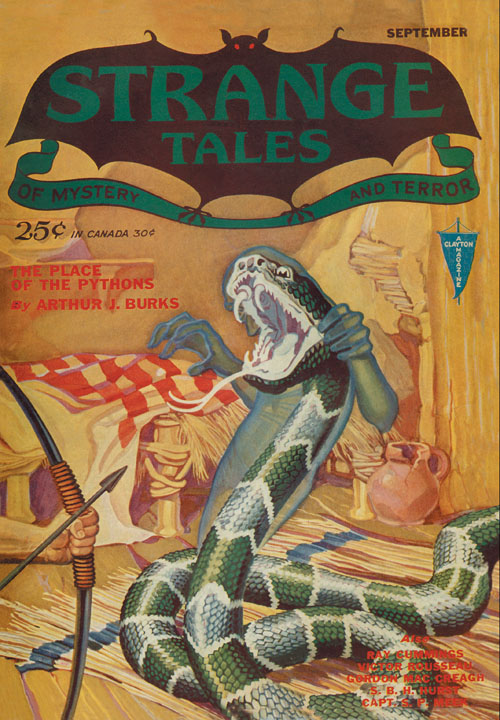Magazine Review: Strange Tales September 1931 edited by Harry Bates
Strange Tales was published as a direct competitor to Weird Tales, the top fantastic/occult story pulp magazine of the time, starting with this issue in 1931. It had more of an action slant to its editorial policy as compared to the more idea-heavy stories of the competition. It attracted some top writers in the genre, and sold pretty well, but the publisher went bankrupt in 1933, closing the series (with a brief revival in the 2000s.) It has no relation to the Strange Tales comic books put out by Marvel Comics when they found out the trademark was open.

“The Dead Who Walk” by Ray Cummings opens the magazine with a man dying of no apparent cause–then appearing alive again! It’s swiftly learned that he’s not the only one as an epidemic of grave robbery strikes the county. How are the dead returning to life, and what do they intend? The best bit is one of the evil dead screwing up because he’s a little too anxious to return to life.
“The Place of the Pythons” by Arthur J. Burks is the cover story, and it is a very nice cover by H.W. Wesso, check out those details. The story itself is of an alcoholic stealing from a Filipina bartender and being cursed, either with actually becoming a python, or experiencing a vivid hallucination of becoming a python. The ending leaves it a bit vague. Some unfortunate racist overtones.
“The Dark Castle” by Marion Brandon has two travelers stranded in the mountains of Roumania. The one who’s local assures the foreigner that they’re in no danger. While of course there are such things as vampires and werewolves, this particular region is free of such infestations. But what if he’s wrong?
“Dr. Muncing, Exorcist” by Gordon MacCreagh seems likely to be the first of a series of stories about the title character. He’s investigating a vague sense of evil in a modern house in the Catskills. The inhabitants are baffled; there’s not even an Indian burial ground nearby! Mind, the wife has been holding seances, and Dr. Muncing discovers that she’s called up not a ghost, but an “elemental” hostile to humanity. “And there is no Yogi spell to send it back.”
“The Dog that Laughed” by Charles Willard Diffin is a mad scientist story. Can you separate a dog’s, or a man’s, personality in to separate parts by hypnosis and plant those parts in another body? Dr. Strogher is going to give it the old college try!
“The Return of the Sorcerer” by Clark Ashton Smith is the most reprinted story from this issue, probably because it’s connected to the Cthulhu mythos. (Lovecraft himself only got into Strange Tales through ghost writing; his own stories were considered too cerebral.) An impoverished scholar is eager to take a secretarial job which requires his knowledge of Arabic. He’s less thrilled when he learns part of his task involves translating passages from the Necronomicon. His employer fears the title event, which comes to pass, and there’s some effectively creepy imagery.
“Nasturtia” by Capt. S.P. Meek is a tale of reincarnation. A military man loves nasturtiums and hates roses, and this turns out to be the result of an age-old love triangle, with him continually reincarnating and attempting to atone for his long-ago sin. Buddhists may find the portrayal of Buddha less than convincing, or possibly even insulting. (And the rose is given no chance to improve herself, but must remain evil always.)
“A Cry From Beyond” by Victor Rousseau also has an elemental spirit called up by careless dabbling in the occult. I liked the image of a tranced medium being like an open party line, with pranksters and elementals and the rare sincere spirit all trying to talk at once, and the pranksters having the loudest voices. And when the sincere spirit tries to get through, it must talk obliquely rather than give straight answers. The Chinese character is a supposedly humorous stereotype.
“The Awful Injustice” by S.B.H. Hurst closes out the issue with the tale of a respected judge who is haunted by the idea that somewhere, somehow, he’s judged incorrectly and done a grave injustice. A search of his case records shows no irregularity, and ordinary psychology does nothing. At this point, what could hypnotism hurt? As it happens, it could reveal the horrible truth!
There’s also a couple of short fillers, including how St. Agnes murdered the giant Bolster for being a stalker.
As mentioned, the Clark Ashton Smith story has been reprinted several times, but if you’d like to see it in its original setting, this Adventure House facsimile reprint is very nice.

